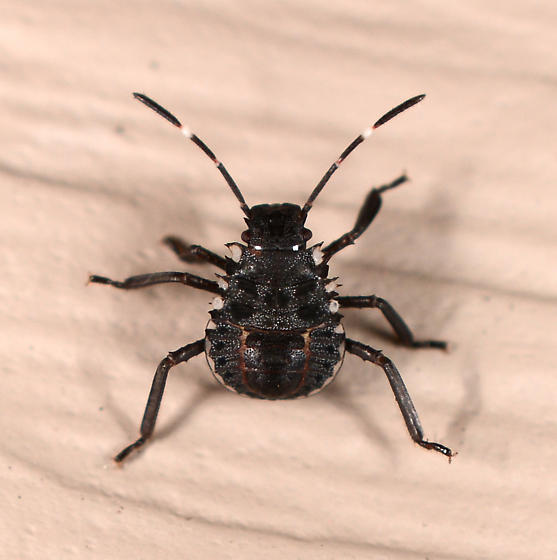-
If you need help identifying a pepper, disease, or plant issue, please post in Identification.
You are using an out of date browser. It may not display this or other websites correctly.
You should upgrade or use an alternative browser.
You should upgrade or use an alternative browser.
tutorial The Pest Guide
- Thread starter Cayennemist
- Start date
In looking for some more information on the Brown Marmorated Stink Bug (BMSB), I stumbled across some photographs and other information that may be of help to others in indentification of the b******s.
From http://www.stopbmsb.org/stink-bug-basics/life-stages/
From left to right, four nymphal stages of BMSB (second through fifth instar), adult male, and adult female. Photo by W. Hershberger

BMSB nymphs, first instar, cluster around a mass of newly-hatched eggs on the underside of a leaf. Photo by W. Hershberger
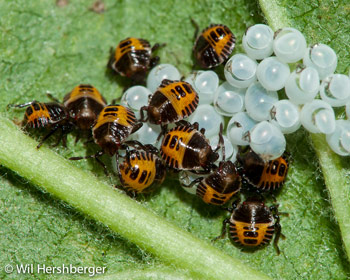
And, from https://njaes.rutgers.edu/stink-bug/identify.php:
The Brown Marmorated Stink Bug has a "shield" shaped body that is characteristic of all stink bugs. The adults are approximately 17 mm (5/8 inch) long with a mottled brownish grey color. The next to last (4th) antennal segment has a white band and several of the abdominal segments protrude from beneath the wings and are alternatively banded with black and white. The underside is white, sometimes with grey or black markings, and the legs are brown with faint white banding.
Adult Male
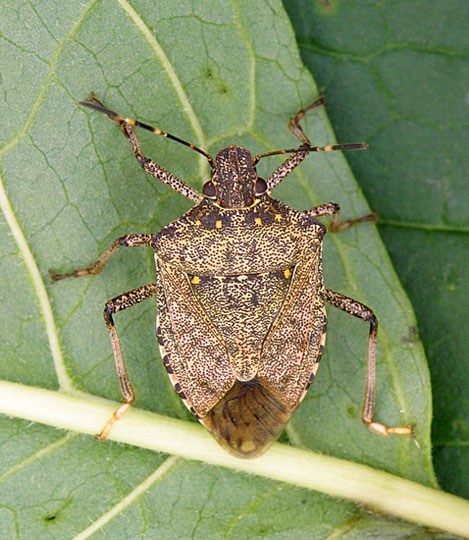
Adult Female
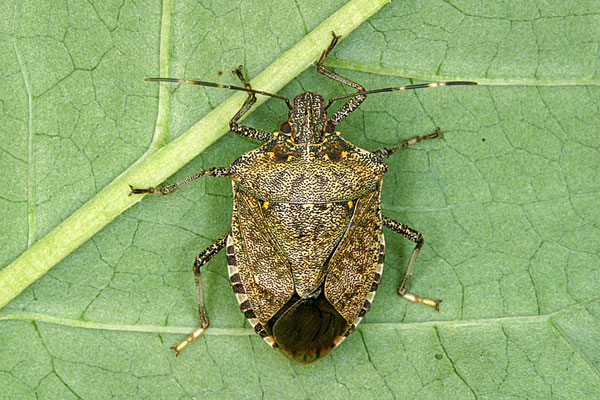
Aggregation on Crab Apple Leaf.
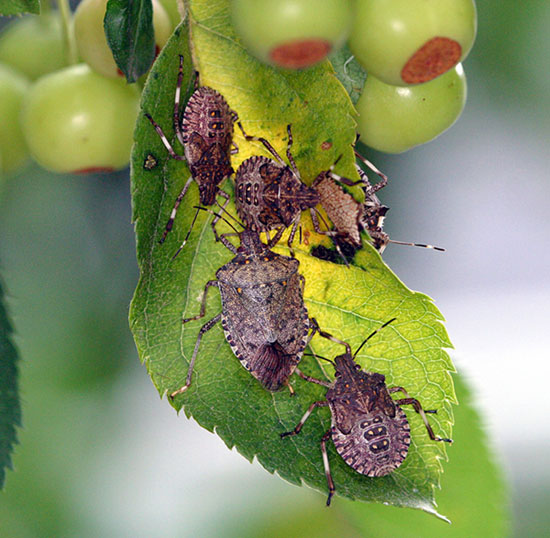
The Brown Marmorated Stink Bug has five nymphal stages, or instars, and ranges in size from 2.4 mm to 12 mm in length. Unlike the adults who blend in very well with bark, the nymphs are more brightly colored with red and black. The first instars, which have a "tick-like" appearance, are not very active and remain around the hatched egg mass. Nymphs are characterized by dark reddish eyes and a yellowish-red abdomen that is also striped with black. The legs and antennae of the nymphs are black with white banding.
Eggs of the Brown Marmorated Stink Bug.
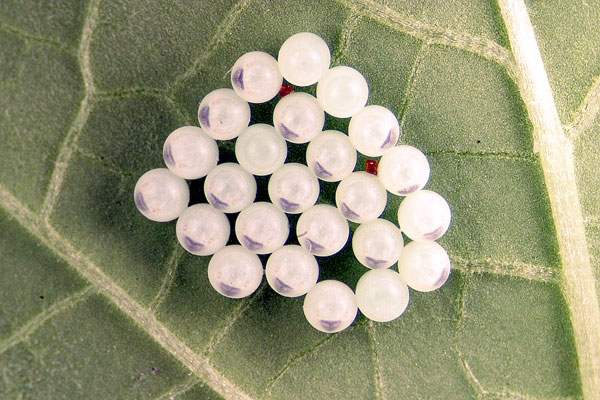
The eggs of the Brown Marmorated Stink Bug are often laid on the underside of leaves and a light green in color. They are elliptical in shape and are often deposited in a mass of approximately 28 eggs.
First Instar.
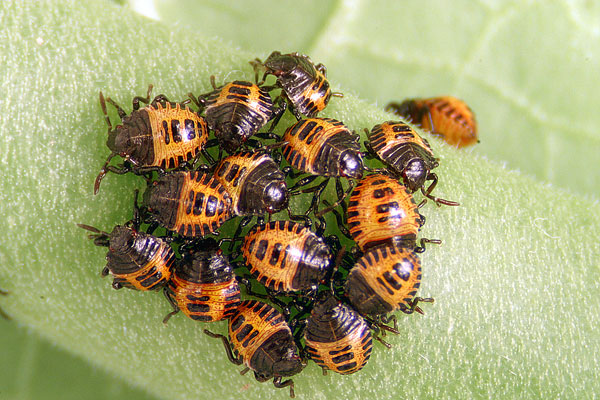
Fourth Instar.
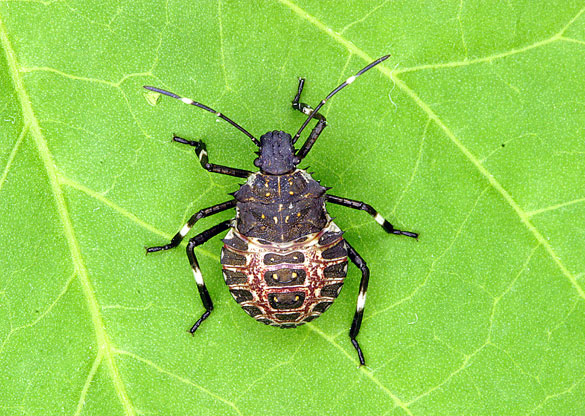
From http://www.stopbmsb.org/stink-bug-basics/life-stages/
From left to right, four nymphal stages of BMSB (second through fifth instar), adult male, and adult female. Photo by W. Hershberger

BMSB nymphs, first instar, cluster around a mass of newly-hatched eggs on the underside of a leaf. Photo by W. Hershberger

And, from https://njaes.rutgers.edu/stink-bug/identify.php:
The Brown Marmorated Stink Bug has a "shield" shaped body that is characteristic of all stink bugs. The adults are approximately 17 mm (5/8 inch) long with a mottled brownish grey color. The next to last (4th) antennal segment has a white band and several of the abdominal segments protrude from beneath the wings and are alternatively banded with black and white. The underside is white, sometimes with grey or black markings, and the legs are brown with faint white banding.
Adult Male

Adult Female

Aggregation on Crab Apple Leaf.

The Brown Marmorated Stink Bug has five nymphal stages, or instars, and ranges in size from 2.4 mm to 12 mm in length. Unlike the adults who blend in very well with bark, the nymphs are more brightly colored with red and black. The first instars, which have a "tick-like" appearance, are not very active and remain around the hatched egg mass. Nymphs are characterized by dark reddish eyes and a yellowish-red abdomen that is also striped with black. The legs and antennae of the nymphs are black with white banding.
Eggs of the Brown Marmorated Stink Bug.

The eggs of the Brown Marmorated Stink Bug are often laid on the underside of leaves and a light green in color. They are elliptical in shape and are often deposited in a mass of approximately 28 eggs.
First Instar.

Fourth Instar.

I've been dealing with them myself and you're right they are the scourge of the earth!!
Sent from my XT1565 using Tapatalknmlarson said:In looking for some more information on the Brown Marmorated Stink Bug (BMSB), I stumbled across some photographs and other information that may be of help to others in indentification of the b******s.
From http://www.stopbmsb.org/stink-bug-basics/life-stages/
From left to right, four nymphal stages of BMSB (second through fifth instar), adult male, and adult female. Photo by W. Hershberger

BMSB nymphs, first instar, cluster around a mass of newly-hatched eggs on the underside of a leaf. Photo by W. Hershberger

And, from https://njaes.rutgers.edu/stink-bug/identify.php:
The Brown Marmorated Stink Bug has a "shield" shaped body that is characteristic of all stink bugs. The adults are approximately 17 mm (5/8 inch) long with a mottled brownish grey color. The next to last (4th) antennal segment has a white band and several of the abdominal segments protrude from beneath the wings and are alternatively banded with black and white. The underside is white, sometimes with grey or black markings, and the legs are brown with faint white banding.
Adult Male

Adult Female

Aggregation on Crab Apple Leaf.

The Brown Marmorated Stink Bug has five nymphal stages, or instars, and ranges in size from 2.4 mm to 12 mm in length. Unlike the adults who blend in very well with bark, the nymphs are more brightly colored with red and black. The first instars, which have a "tick-like" appearance, are not very active and remain around the hatched egg mass. Nymphs are characterized by dark reddish eyes and a yellowish-red abdomen that is also striped with black. The legs and antennae of the nymphs are black with white banding.
Eggs of the Brown Marmorated Stink Bug.

The eggs of the Brown Marmorated Stink Bug are often laid on the underside of leaves and a light green in color. They are elliptical in shape and are often deposited in a mass of approximately 28 eggs.
First Instar.

Fourth Instar.

Spotted Lanternfly (SLF)
A new, destructive, invasive pest. It's currently been reported in 13 counties in SE Pennsylvania, one county in Virginia and three in New Jersey. This one was found outside Macungie, PA in Lehigh County. The PennState Extension is requesting citizens finding the SLF to report it via their website: https://extension.psu.edu/have-you-seen-a-spotted-lanternfly
Top view. Wings and body total about one inch. Notice the red edge of the bottom wings peeking through to the top:

Bottom view:

A new, destructive, invasive pest. It's currently been reported in 13 counties in SE Pennsylvania, one county in Virginia and three in New Jersey. This one was found outside Macungie, PA in Lehigh County. The PennState Extension is requesting citizens finding the SLF to report it via their website: https://extension.psu.edu/have-you-seen-a-spotted-lanternfly
Top view. Wings and body total about one inch. Notice the red edge of the bottom wings peeking through to the top:
Bottom view:
Got a nice brood of orange Leaf-footed nymphs.
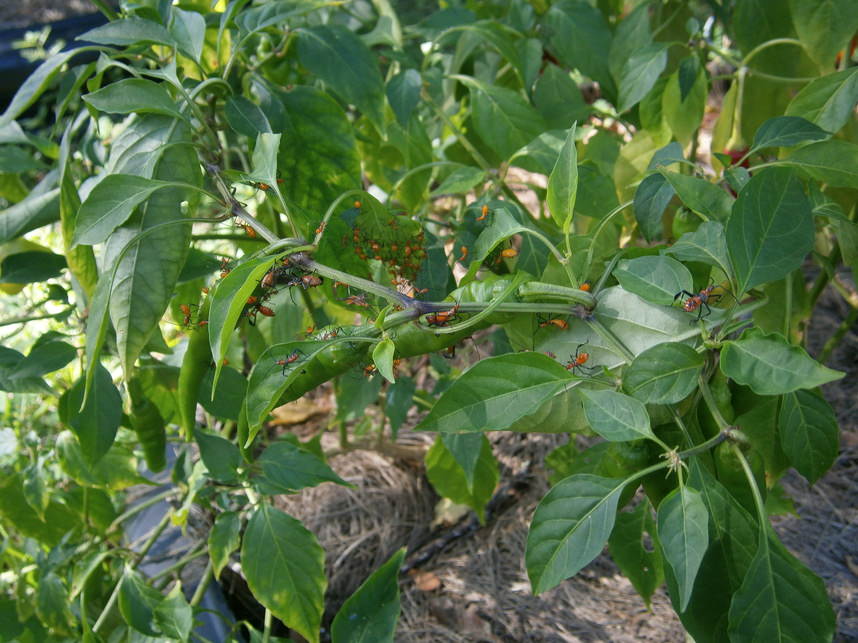
They nearly always infest my plants when they're fruiting. So I'm reluctant to use any pesticide (even the "organic" ones) on peppers I'm about to harvest.
But I've had good luck just spraying them with soapy water. The soap suds overwhelm their lungs, and they drown. There's usually a few that get away, but they tend to come back to the same spot. So I usually have to repeat the exercise the next day, but on a much smaller brood.
I always wash the soap off the plants with a hose afterwards. If I had the right soap, I wouldn't even need to do that.

They nearly always infest my plants when they're fruiting. So I'm reluctant to use any pesticide (even the "organic" ones) on peppers I'm about to harvest.
But I've had good luck just spraying them with soapy water. The soap suds overwhelm their lungs, and they drown. There's usually a few that get away, but they tend to come back to the same spot. So I usually have to repeat the exercise the next day, but on a much smaller brood.
I always wash the soap off the plants with a hose afterwards. If I had the right soap, I wouldn't even need to do that.
Anybody know what this is?
Think it or it's friends have laid eggs in my grow the past weeks because I found fresh holes this weekend on the leafs of a neighbouring plant.


Made me paranoid so took the plant in under the scope and found some dead relics from the last war I won against broadmites. However I didn't know they had support from those bigger brown ones, never seen them before. What are they?


Think it or it's friends have laid eggs in my grow the past weeks because I found fresh holes this weekend on the leafs of a neighbouring plant.
Made me paranoid so took the plant in under the scope and found some dead relics from the last war I won against broadmites. However I didn't know they had support from those bigger brown ones, never seen them before. What are they?
After having repeated attacks on my shishitos from broad mites, I think they're easily the worst kind of small pest to deal with.
You generally won't even notice you have an infestation until they've already caused long lasting damage, as I've had my plants go from looking fine to having shriveled new growth within the span of a day.
You don't even need a large number of them for significant damage to occur due to the leaf-warping toxins they inject, which is awful when considering that they ride on other pests like whiteflies and can thus re-infest an unprotected plant at pretty much any time.
You generally won't even notice you have an infestation until they've already caused long lasting damage, as I've had my plants go from looking fine to having shriveled new growth within the span of a day.
You don't even need a large number of them for significant damage to occur due to the leaf-warping toxins they inject, which is awful when considering that they ride on other pests like whiteflies and can thus re-infest an unprotected plant at pretty much any time.
Disregard.
No idea how to delete unwanted posts in this forum format.
No idea how to delete unwanted posts in this forum format.
Does anyone have an answer to serpentine leaf miner flies?
These things are annoying because they're rather indiscriminate about the plants they target and will go after even strongly scented plants like garlic, marigolds, and peppermint that most pests avoid, meaning that companion planting or spraying essential oils doesn't seem to do much to deter them. They definitely aren't put off by the smell of neem oil as I still see them on the leaves occasionally despite a weekly spraying routine using one and a half teaspoons of cold-pressed neem and a half teaspoon Dr. Bronner's peppermint soap in a quart of water.
They also lay their eggs IN the leaves of plants, meaning they're protected unlike some other types of leaf miners that simply deposit them on the surface which leaves them open to direct spraying and hand removal.
If they get into a small leaf, one larvae can cause enough damage just in the span of a few days to make the leaf turn yellow and fall off. The only semi-effective method of dealing with them I've found is to gently trace their trails using a thin stick of the same width as their mine to crush them, but this is naturally a bit tedious and will become moreso as the plants get bigger.
While placing yellow sticky traps does catch some of them, it also catches the parasitic wasps and ladybugs so I feel a bit reluctant to resort to those.
These things are annoying because they're rather indiscriminate about the plants they target and will go after even strongly scented plants like garlic, marigolds, and peppermint that most pests avoid, meaning that companion planting or spraying essential oils doesn't seem to do much to deter them. They definitely aren't put off by the smell of neem oil as I still see them on the leaves occasionally despite a weekly spraying routine using one and a half teaspoons of cold-pressed neem and a half teaspoon Dr. Bronner's peppermint soap in a quart of water.
They also lay their eggs IN the leaves of plants, meaning they're protected unlike some other types of leaf miners that simply deposit them on the surface which leaves them open to direct spraying and hand removal.
If they get into a small leaf, one larvae can cause enough damage just in the span of a few days to make the leaf turn yellow and fall off. The only semi-effective method of dealing with them I've found is to gently trace their trails using a thin stick of the same width as their mine to crush them, but this is naturally a bit tedious and will become moreso as the plants get bigger.
While placing yellow sticky traps does catch some of them, it also catches the parasitic wasps and ladybugs so I feel a bit reluctant to resort to those.
My only experience with leaf miners was this past winter while vacationing in Florida. I had a tomato plant which I had started here at home in Pennsylvania and took to Florida with me. While there, I noticed the damage from the leaf miner. I never did see a fly, or a worm, and ended up just cutting off the damaged leaves. Since BT is a biological, I wonder if you could spray it, as it's good for caterpillar insects.
Leaf miners are pretty inconsequential. Meaning, they're not likely to cause plant failure.
.
Yes, they make leaves ugly. And yes, Neem does work on them. But they have to be eating, for it to do so. So they do their damage by the time the solution works. (thus, leaving the appearance of nothing being done)
.
In truth, we need to accept that as long as we're growing outdoors, there is going to be something that creates imperfections in our plants. If perfect specimens are desired, you will either have to go ape, spraying harsh stuff, or you'll need to grow indoors. Otherwise, it's a healthy attitude to accept that there's enough for everyone, so long as nobody gets too greedy. Leaf miners? Meh. An old leaf falls, a new one grows in its place...
.
Yes, they make leaves ugly. And yes, Neem does work on them. But they have to be eating, for it to do so. So they do their damage by the time the solution works. (thus, leaving the appearance of nothing being done)
.
In truth, we need to accept that as long as we're growing outdoors, there is going to be something that creates imperfections in our plants. If perfect specimens are desired, you will either have to go ape, spraying harsh stuff, or you'll need to grow indoors. Otherwise, it's a healthy attitude to accept that there's enough for everyone, so long as nobody gets too greedy. Leaf miners? Meh. An old leaf falls, a new one grows in its place...
It's REALLY hard to say. Harder because there is no profile of the thorax and top view, and it's difficult to tell if the wings are dark or transparent, can't make out eye shape, etc.
.
However... Based on what I can see, and the size you provided, it may possibly be a variety of sweat bee. There are lots of variations, but this roughly fits the profile of at least a few types. Some look like regular bees, some are black or iridescent colored.
.
Parasitic wasps tend to be either similar in size to the wasps that we go out of our way to avoid, OR very small - even tiny. For example, the wasp that parasitizes aphids, is about the size of a gnat. I'm not familiar with any parasitic wasps that are the size shown in the photo.
.
However... Based on what I can see, and the size you provided, it may possibly be a variety of sweat bee. There are lots of variations, but this roughly fits the profile of at least a few types. Some look like regular bees, some are black or iridescent colored.
.
Parasitic wasps tend to be either similar in size to the wasps that we go out of our way to avoid, OR very small - even tiny. For example, the wasp that parasitizes aphids, is about the size of a gnat. I'm not familiar with any parasitic wasps that are the size shown in the photo.
solid7 said:It's REALLY hard to say. Harder because there is no profile of the thorax and top view, and it's difficult to tell if the wings are dark or transparent, can't make out eye shape, etc.
.
However... Based on what I can see, and the size you provided, it may possibly be a variety of sweat bee. There are lots of variations, but this roughly fits the profile of at least a few types. Some look like regular bees, some are black or iridescent colored.
.
Parasitic wasps tend to be either similar in size to the wasps that we go out of our way to avoid, OR very small - even tiny. For example, the wasp that parasitizes aphids, is about the size of a gnat. I'm not familiar with any parasitic wasps that are the size shown in the photo.
Thank you for your observations and opinions. I'll see if I can get better photos, as there are a LOT of these little critters around.
I noticed today that the leaf miners really like bean plants.
Enough that I see them constantly milling about on them when I normally seldom see them and also enough to make them ignore my pepper plants ever since I got them.
I guess using bait plants is an effective method of handling these.
Enough that I see them constantly milling about on them when I normally seldom see them and also enough to make them ignore my pepper plants ever since I got them.
I guess using bait plants is an effective method of handling these.
acs1 said:Whats a safe amount of time to wait after spraying with neem before plant gets sun light.? Will being in the shade but getting indirect sun, hurt a freshly neem sprayed plant..?
The purpose of spraying a plant after sundown, is because that's when the stomata on the leaves are closed. You want to coat the leaves, not fill in the pores. So absolutely DO NOT spray during the day, even in indirect sunlight.

